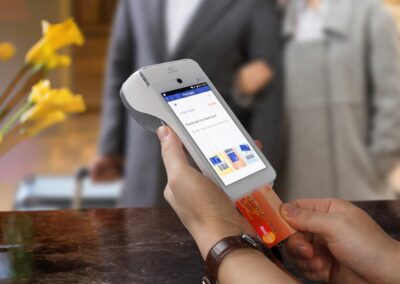Operating a restaurant business is both an exciting and challenging endeavor. Restaurant owners can indulge in their culinary passion by creating new flavors and experimenting with culinary techniques while meeting food enthusiasts from all walks of life.
At the same time, the restaurant business can be marked by intense competition, thin profit margins, and day-to-day complications of running a restaurant successfully. Hence, the balance of creating an exceptional customer dining experience, managing the staff, and maximizing profits requires new tools and insights.
Technology is revolutionizing the restaurant business by enhancing efficiency, customer experiences, and overall operations. The point-of-sale system (POS) has taken center stage in this context. In this blog, we’ll explain how a POS system achieves these tasks, potentially leading to business growth.
Amidst the fast-paced nature of restaurants and the multiple steps needed for handwritten orders, human errors can easily occur — and they come at a cost. Poor handwriting or unclear abbreviations can cost the kitchen time or additional ingredients. On average, a wrong order can cost the restaurant $30 per order, adding up to as much as several thousand dollars a month, depending on the restaurant.
However, this is precisely one of the reasons why POS systems were created. Here’s how a POS system reduces errors, thereby resulting in cost savings that restaurant owners can funnel back into their restaurant business:
- Accuracy: With a POS system, servers take orders digitally to replace handwritten notes. Servers utilize user-friendly interfaces to enter orders, which are then quickly and accurately sent to the kitchen or bar. This digital flow of information is facilitated by essential hardware like kitchen display systems and in-kitchen printers, seamlessly integrated into the POS software. A POS system eliminates the risk of illegible handwriting that can lead to menu order mix-ups. It’s like having your best server on their best day, every day.
- Order customization: A POS system allows servers to easily accommodate customer modifications and special requests. Whether it’s extra sauce, an ingredient on the side, a gluten-free option, an allergy, or a specific cooking preference (e.g., scrambled eggs instead of fried), the digital format ensures that these details are clear and accurately communicated to the kitchen staff.
- Real-time communication: The seamless communication between the servers and the kitchen staff minimizes the chances of inaccurate or incomplete information. The kitchen staff receive orders in a simple format, like a kitchen display system, to avoid making mistakes while preparing food.
- Automated calculations: POS systems perform real-time calculations for the total cost of the order, including tax. POS systems minimize billing errors, ensuring that staff members charge their customers the correct amount.
Satisfied customers are more likely to become repeat patrons and even brand advocates. A POS system plays a pivotal role in enhancing the dining experience by providing:
- Faster service: A customer’s initial interaction with a business often sets the tone for their entire experience. Prolonged wait times can negatively affect the customer’s perception of the restaurant. On the other hand, shorter wait times lead to overall customer satisfaction.
- Personalization: POS systems store customer preferences and dining habits, allowing staff to give personalized recommendations. For example, suppose a repeat customer frequently orders gluten-free dishes. They can suggest a gluten-free pizza crust when the person orders pizza. This level of care and attention creates a memorable experience for the customer, which can result in word-of-mouth recommendations to their family and friends.
- Flexible payment options: Accepting various payment methods, including mobile wallets and contactless payments, caters to a broader customer base. By accepting payments from diverse sources, restaurant owners can expand their clientele. POS systems usually come with a card reader and payment processor which efficiently takes in payment information.
- Loyalty programs: Many POS systems integrate loyalty programs, allowing restaurants to reward frequent customers and build customer loyalty. Customers can earn rewards or points with each purchase, encouraging repeat visits. Restaurant owners can personalize loyalty programs to offer rewards based on the given customer. For example, a restaurant can provide a free dessert with a meal purchase or a “buy two appetizers, get one free” promo during happy hour.
In the digital age of data, insights are invaluable. A POS system collects and analyzes data that can guide strategic decisions. POS systems offer insight into:
- Sales data: A POS system stores sales data by item, time, and day. The data allows restaurant owners to identify trends such as popular menu items and seasonal fluctuations. Restaurant owners can optimize their ingredients and fine tune the management of kitchen inventory by tracking sales trends. Knowing which items are selling well and which aren’t can help reduce waste, improve cash flow, and satisfy customers. For example, if a dish featuring pumpkin sells well in the fall, restaurant owners can take advantage and increase sales by ensuring all the dish’s ingredients are well stocked.
- Peak hours: Knowing your restaurant’s peak hours can help you maximize revenue. A POS system provides precise data on when your restaurant is the busiest. By identifying peak hours, you can schedule staff more effectively to ensure an adequate number of servers, thereby enhancing customer service and improving customer satisfaction. In addition, you can run special promotions during the most active hours to increase your revenue stream.
A POS system helps restaurant owners overcome challenges and helps them adjust to customer preferences. Additionally, it contributes to their success in an industry that relies on data-driven decisions. By leveraging the insights a POS system provides, restaurant businesses can grow and create memorable dining experiences that keep customers returning. As a leading provider of POS systems, Tonic makes restaurant management easy. Whether you’re the general manager of a Michelin-star restaurant or the most popular happy hour spot in town, VersiPOS gives you greater operational efficiency. Contact us to learn how you can start using Tonic.POS for your restaurant today.






